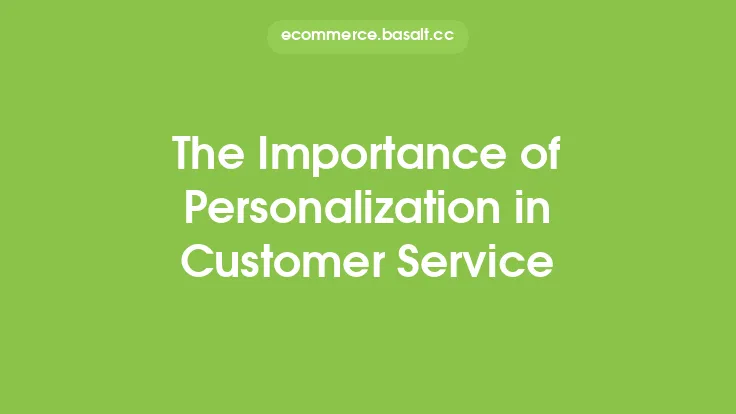In today's fast-paced e-commerce landscape, providing exceptional customer experiences is crucial for businesses to stay ahead of the competition. One key strategy for achieving this is by streamlining customer interactions, which can be effectively accomplished through the integration of Customer Relationship Management (CRM) systems. CRM integration enables businesses to manage customer interactions across multiple touchpoints, providing a unified and seamless experience that fosters loyalty, trust, and ultimately, drives sales.
What is CRM Integration?
CRM integration refers to the process of connecting a CRM system with other business applications, such as marketing automation tools, customer service software, and e-commerce platforms. This integration allows for the free flow of customer data between systems, providing a comprehensive view of customer interactions and enabling businesses to respond promptly to customer needs. By integrating CRM with other systems, businesses can automate routine tasks, enhance customer insights, and improve the overall efficiency of their customer-facing operations.
Benefits of CRM Integration
The benefits of CRM integration are numerous and can have a significant impact on a business's bottom line. Some of the key advantages include:
- Improved Customer Insights: CRM integration provides a unified view of customer interactions, enabling businesses to gain a deeper understanding of customer behavior, preferences, and needs.
- Enhanced Customer Experience: By providing a seamless and personalized experience across multiple touchpoints, businesses can increase customer satisfaction, loyalty, and retention.
- Increased Efficiency: Automation of routine tasks and workflows enables businesses to reduce manual errors, save time, and allocate resources more effectively.
- Better Decision-Making: Access to real-time customer data and analytics enables businesses to make informed decisions, identify new opportunities, and respond quickly to changing market conditions.
- Improved Collaboration: CRM integration facilitates collaboration between different departments, such as sales, marketing, and customer service, ensuring that all teams are aligned and working towards common goals.
Key Features of CRM Integration
When implementing CRM integration, there are several key features to consider. These include:
- Data Synchronization: The ability to synchronize customer data across multiple systems, ensuring that all information is up-to-date and accurate.
- Workflow Automation: The ability to automate routine tasks and workflows, such as lead assignment, follow-up emails, and customer notifications.
- Real-time Analytics: The ability to access real-time customer data and analytics, enabling businesses to monitor performance, identify trends, and make data-driven decisions.
- Integration with Third-Party Apps: The ability to integrate with third-party apps and services, such as social media, email marketing, and customer service software.
- Security and Compliance: The ability to ensure the security and compliance of customer data, adhering to relevant regulations and industry standards.
Best Practices for Implementing CRM Integration
To ensure a successful CRM integration, businesses should follow best practices, such as:
- Define Clear Goals and Objectives: Establish clear goals and objectives for CRM integration, aligning with overall business strategy and customer experience vision.
- Choose the Right CRM System: Select a CRM system that meets business needs, is scalable, and integrates seamlessly with other systems.
- Develop a Comprehensive Integration Plan: Develop a comprehensive integration plan, including data migration, workflow automation, and testing.
- Provide Ongoing Training and Support: Provide ongoing training and support to ensure that all teams are proficient in using the CRM system and integrated applications.
- Monitor and Evaluate Performance: Continuously monitor and evaluate the performance of CRM integration, identifying areas for improvement and optimizing workflows and processes.
Common Challenges and Solutions
While CRM integration can offer numerous benefits, there are also common challenges that businesses may encounter. These include:
- Data Quality Issues: Poor data quality can hinder the effectiveness of CRM integration, leading to inaccurate insights and inefficient workflows.
- Integration Complexity: Integrating multiple systems can be complex, requiring significant time, resources, and expertise.
- Change Management: Implementing CRM integration can require significant changes to business processes, workflows, and culture, which can be challenging to manage.
- Security and Compliance: Ensuring the security and compliance of customer data is critical, requiring robust measures to protect against data breaches and cyber threats.
Future of CRM Integration
The future of CRM integration is exciting, with emerging trends and technologies, such as artificial intelligence, machine learning, and the Internet of Things (IoT), set to revolutionize the way businesses interact with customers. As CRM systems become more sophisticated, businesses can expect to see:
- Increased Use of AI and Machine Learning: AI and machine learning will play a greater role in CRM integration, enabling businesses to predict customer behavior, personalize experiences, and automate routine tasks.
- Greater Emphasis on Customer Experience: Customer experience will become an even greater priority, with businesses focusing on creating seamless, omnichannel experiences that meet evolving customer needs.
- More Integration with Emerging Technologies: CRM integration will extend to emerging technologies, such as IoT, augmented reality, and virtual reality, enabling businesses to create innovative, immersive experiences that drive engagement and loyalty.
Conclusion
In conclusion, CRM integration is a powerful strategy for streamlining customer interactions, providing a unified and seamless experience that fosters loyalty, trust, and drives sales. By understanding the benefits, key features, and best practices of CRM integration, businesses can unlock the full potential of their customer-facing operations, stay ahead of the competition, and thrive in today's fast-paced e-commerce landscape. As CRM integration continues to evolve, businesses must stay agile, adapt to emerging trends and technologies, and prioritize customer experience to remain competitive and achieve long-term success.





